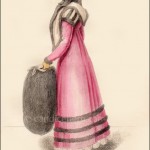Journal des Dames et des Modes, Paris, January 22, 1817.
“Chapeau de pluche de Soie. Redingote de Lévantine.”
 This is clearly a walking ensemble, but looks as though it could also work as a carriage dress for travel.
This is clearly a walking ensemble, but looks as though it could also work as a carriage dress for travel.
When applied to women’s fashion, the French term redingote is typically translated as a coat dress or a three-quarter or full-length over coat, a lighter version of the male redingote. It was often open in the front to reveal the dress underneath, but we can’t tell if that is the case here because of the angle of the model.
The pink coat is made of levantine, which is a twilled sarsnet. That seems a bit lightweight for a winter coat (sarsnet is a type of silk), but silk can be warm, and it is trimmed in all that white fur. The brief description beneath the print (the magazine text does not describe the print) has no mention of the type of fur. In fact, we cannot know for sure that it is fur. It might be made of the same material as the hat, silk pluche, which is a plush fabric with a deeper pile than velvet.
The redingote is trimmed deeply at the hem with the white fur or pluche. Over the coat is worn a short capelet or tippet made of the same material, and she wears a large white muff, also likely of the same material. Note the pink shoes are also trimmed in the white fur or pluche. (They almost look like the house slippers my mother used to wear, way back when!)
The pink pluche hat has the broad brim and high crown typical of the period. It looks as though it might be soft and unstructured, though it just as well might have a stiffened fabric under the pluche to give it more shape. Note that a wide length of lace hangs down over the left side of the hat.







